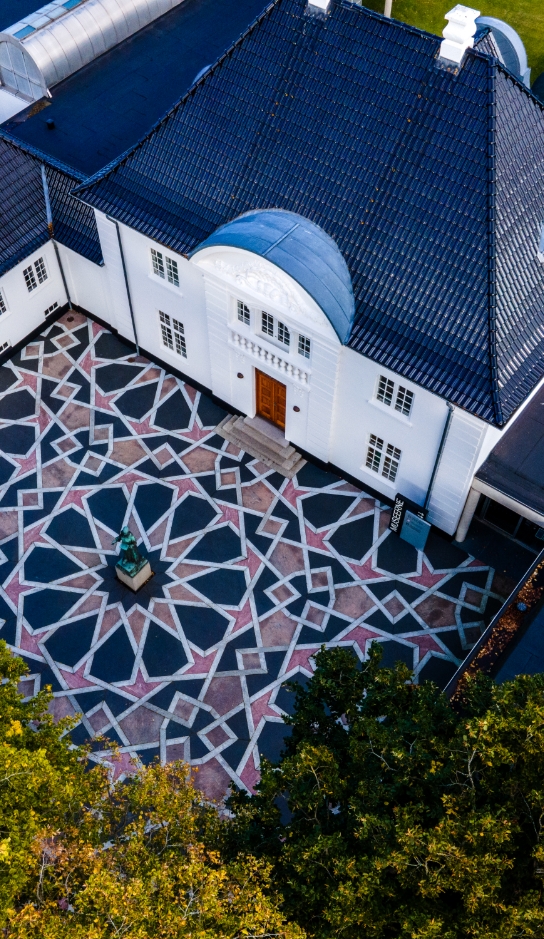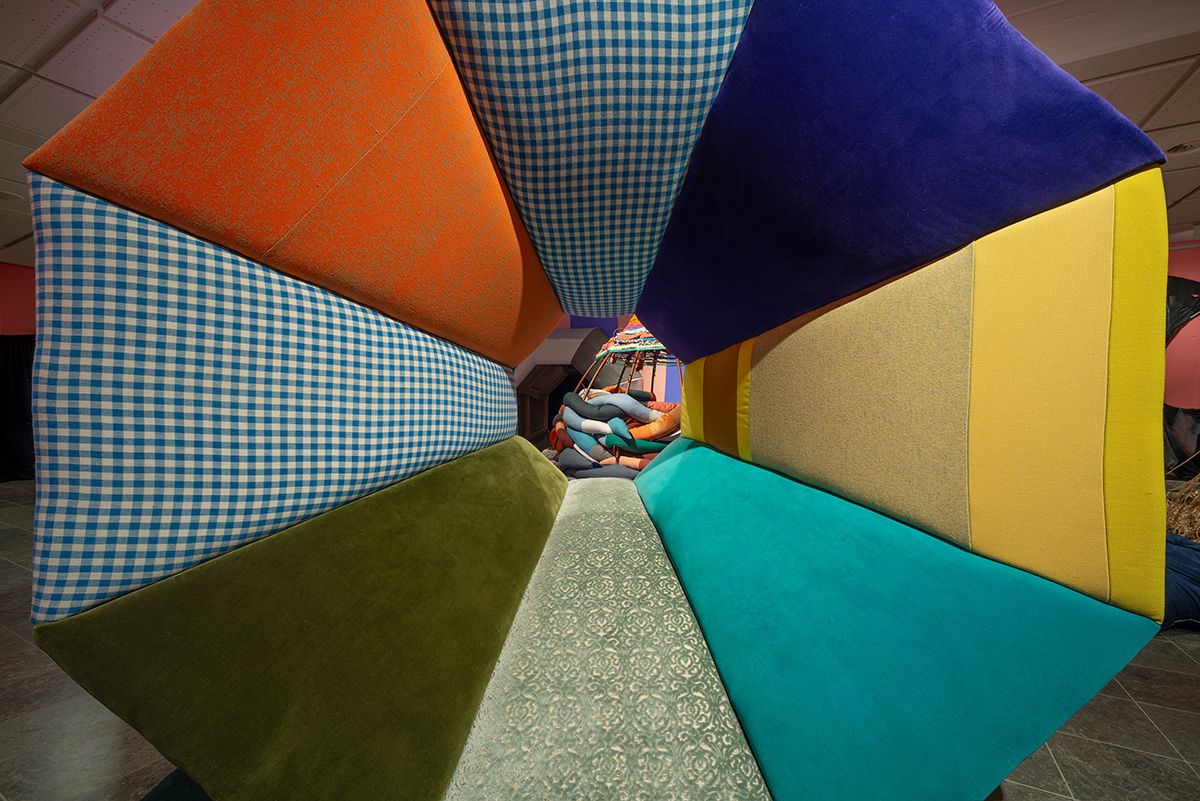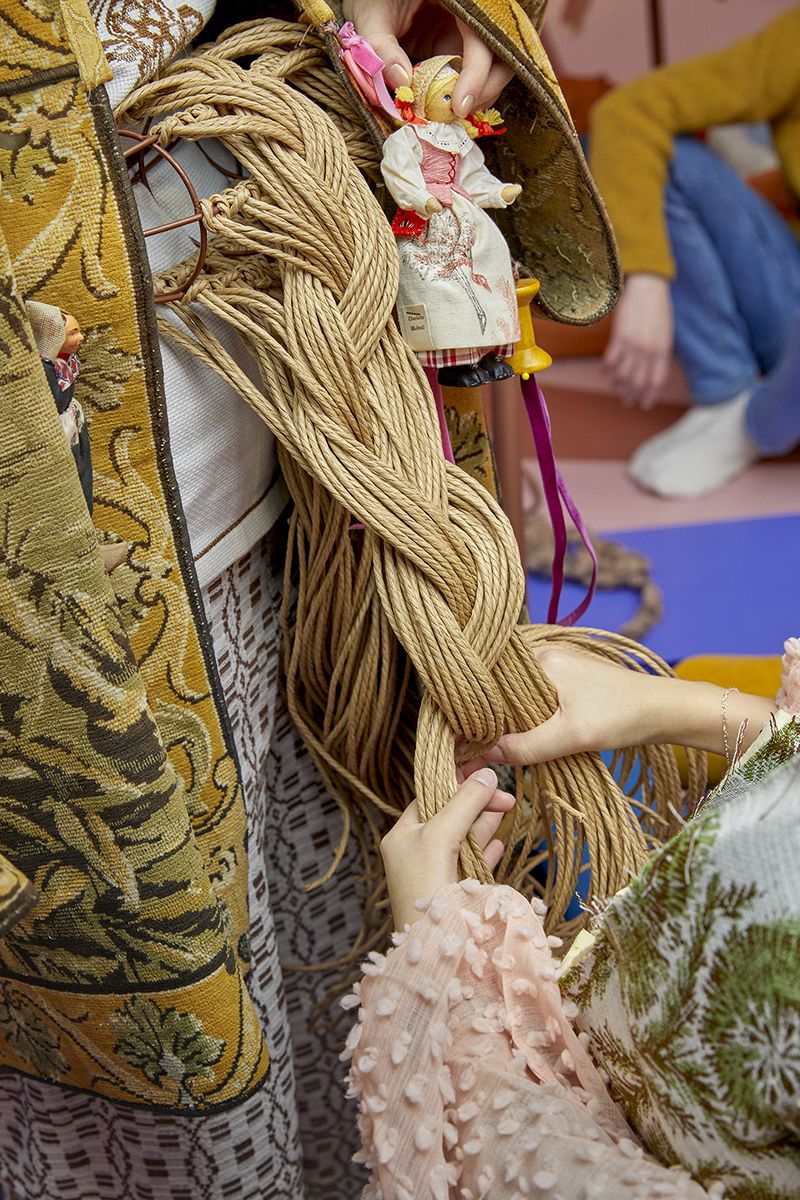FABRICA - Eva Steen Christensen & Nikolaj Danielsen
Special exhibition
You can touch, see and listen. This is not usually the case in a museum but the sensory exhibition FABRICA is different. Here, it is all about telling stories and opening up to new and different universes; appeal to curiosity and exploration – to touch, listen, smell, crawl, dress up and play a role.
The exhibition FABRICA centers around textiles as an inanimate everyday object: as clothing, as symbol, identity and material. Inspired by the both colourful and pitch-black universe of folklore, visual artist Eva Steen Christensen (b. 1969) and scenographer Nikolaj Danielsen (b. 1966) have together woven an environment of recycled textiles.
FABRICA leads us into the universe of folk tales. It is a recycled tale woven from discarded pieces of clothing and framed by a sound composition of scissors, sewing machines, collective song, piano and the characteristic nostalgia of the barrel organ. As in folk tales, you are led through the wardrobe, under the wig and into a sea of wavy fabric.
Stitched-together collages of gray and bluish textiles add nuances in the darkness, where you meet strange, inside-out clothing which lie tossed around like dead weight. A funnel forms the entrance to a brightly coloured arena, where soft shapes and braided ribbons encourage play.
In FABRICA, all the usual rules are lifted. Concepts are turned upside down and inside-out. The clothes we know so well are unfolded into a huge tableau with references to the unpredictable play and humour of the carnival.
FABRICA can be experienced as a soft malleable work; a shared body consisting of threads, fabric, ropes and textiles that we can actively shape.
It is a collective tale of dissolution and re-creation. Everyone can create their own story. You can dress up, undress and become part of the work’s creation, or simply follow the floating lanterns, wearing festive clothing, up to the surface again.
The soundscape in the exhibition is created by composer Jomi Massage (b. 1974).
Eva Steen Christensen (b. 1969)
is one of Denmark's most important living sculptors. Her sculptures are dreamy, sensual and thought-provoking. With playful lightness and mathematical precision, she examines the well-known forms, materials and ideas of everyday life. What you know is turned upside down and reassembled to challenge your perception of the world.
Steen Christensen's artistic work ranges from sculpture to drawing, site-specific works and art works in the public space. She includes architectural elements and everyday objects in her works, and they balance somewhere between body, sculpture and architecture. With threads back to surrealism and the carnivalesque, she processes, displaces and distorts familiar objects and materials. The recognizable is transformed into something else, the world is turned inside out, and we experience it in new ways.
Steen Christensen lives in Copenhagen and graduated from City of Bath College and Chelsea School of Arts in London in 1996. Her works are included in several museum collections, including HEART, Museum og Contemporary Art, the New Carlsberg Foundation and ARKEN.
Nikolaj Danielsen (b. 1966)
is a scenographer and production designer on a large number of films and series, including; The Dreamer - Becoming Karen Blixen, A Taste of Hunger, Riders of Justice, Liberty and The Other World, to name a few examples from the extensive list of productions. FABRICA is Danielsen's first art exhibition.
Danielsen is co-founder of the successful Madeleine's Food Theater 2006 - 2015, Artistic director of Holbæk in Pentecost (2015). He has also received the Henning Bahs award for his work with the film QEDA (2018). Danielsen graduated as a production designer from Denmark's Design School in 1996. He lives in Sweden and works in Copenhagen.
Sensing! New Worlds
FABRICA is the first in a series of sensory exhibitions under the common title Sensing! New Worlds (2024-28), created in collaboration between Sorø Kunstmuseum and Holstebro Kunstmuseum.
FABRICA was presented at Sorø Kunstmuseum from 22 March - 11 August 2024.
Catalogue and events
In connection with the exhibition, a catalog with the same title FABRICA - Eva Steen Christensen & Nikolaj Danielsen has been published with texts (in Danish) by the exhibition's curators, Katrine Sofie Jepsen & Mathilde Helnæs, as well as by postdoc, Aarhus University and Holstebro Art Museum, Ane Kirstine Preisler Skovgaard:
"(...) textile or "fabric": Fabrica is derived from the Latin faber, which means (art) crafts or more specifically blacksmith, which in turn is connected to the Indo-European dhabros, which translates as: "one who joins things together beautifully". The word Fabrica can therefore be read in several ways: on the one hand as a reference to the hand-made, to the beautifully joined and perhaps in particular to the woven together. On the other hand the word brings to mind the type of manufacturing that involves much less manual labor - the factory's modern and mechanized mass production (...)."
Excerpt from Ane Kirstine Preisler Skovgaard's text Between the Hands and the Machine.
The publication can be read as part of the exhibition and is available at the museum shop.
It is richly illustrated with photos by Jenny Sundby, Jan Søndergaard and the artists. The publication's layout is designed by Anni's in collaboration with Eva Steen Christensen. Printed by Narayana Press.
The exhibition is accompanied by public tours, lectures and workshops. Read more under the museum's events.
FABRICA is supported by:
Spar Nord Foundation, Augustinus Foundation, The Danish Arts Foundation, Axel Muusfeldt's Foundation, William Demant Foundation, Brand af 1848 Foundation, Knud Højgaard's Foundation, Poul Johansen Foundation and Arne V. Schlesch's Foundation.
The exhibition is sponsored by:
Kvadrat, Randers Reb, Dansk Wilton A/S, the Salvation Army in Denmark and Danish Red Cross.
Sensing! New Worlds is supported by:
The Nordea Foundation, 15 June Foundation and the Færch Foundation.
Textiles are only textiles when fibers are combined, when threads are woven together - laced, spun, braided. As we knot, braid and weave the materials together in FABRICA, we co-create the fabric of which the exhibition is made.



